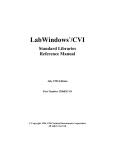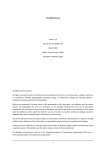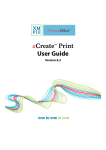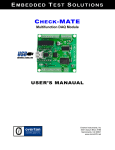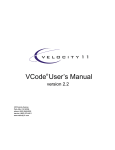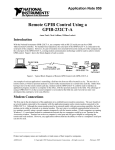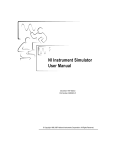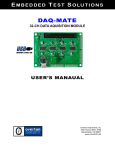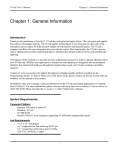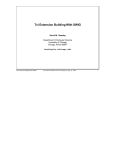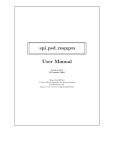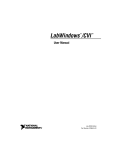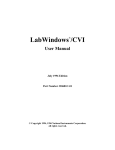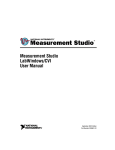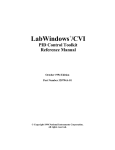Download LabWindows/CVI Version 5.0 Release Notes for Windows
Transcript
RELEASE NOTES LABWINDOWS/CVI VERSION 5.0 RELEASE NOTES FOR WINDOWS Contents Introduction to LabWindows/CVI ...................................................................................4 LabWindows/CVI Installation for Windows ...................................................................4 Minimum System Requirements for Windows 95/NT......................................4 Minimum System Requirements for Windows 3.1 ...........................................4 Installing LabWindows/CVI on a Computer.....................................................5 Installing the Run-Time Engine on a Computer................................................5 Installing the VISA Library...............................................................................6 Installing the IVI Engine ...................................................................................6 What’s New and Different in LabWindows/CVI 5.0 ......................................................6 New Features .....................................................................................................6 Changes to System Requirements .....................................................................7 Toolslib Instrument Drivers ..............................................................................7 Multithreading Limitations on Toolslib Instruments ..........................7 New Sample Programs ......................................................................................7 Changes to the LabWindows/CVI Development Environment.......................................9 Debugging DLLs in Windows 95/NT ...............................................................9 DLL Debugging Menu Item (Windows 95/NT Only) ......................................9 Select External Process......................................................................................10 Automatic Generation of Object Files...............................................................10 Create Dynamic Link Library Dialog Box........................................................11 Breakpoints/Tags in Non-Project Files Are Saved in Project ...........................11 New Control in Watch Expression Dialog Box ................................................11 Activate Panels When Resuming: Clarification ................................................11 New Print Dialog Box .......................................................................................12 New Options for Source File Printing ...............................................................12 Edit Menu ..........................................................................................................12 Code Menu ........................................................................................................12 New Tools Menu ...............................................................................................12 Create ActiveX Automation Controller (Windows 95/NT only)........13 Update ActiveX Automation Controller (Windows 95/NT only) ......13 Create IVI (Intelligent Virtual Instruments) Instrument Driver..........13 CVI ™, National Instruments ™, NI_DAQ ™, NI-VISA ™, the National Instruments logo, and The Software is the Instrument ™ are trademarks of National Instruments Corporation. Product and company names are trademarks or trade names of their respective companies. 320689E-01 © Copyright 1994, 1998 National Instruments Corp. All rights reserved. February 1998 Edit Instrument Attributes .................................................................. 13 Edit Function Tree .............................................................................. 14 Edit Function Panel ............................................................................ 14 Generate Source for Instrument Driver Functions.............................. 14 Go To Definition ................................................................................ 14 Go To Declaration .............................................................................. 14 Enable Auto Replace .......................................................................... 14 Generate IVI C++ Wrapper ................................................................ 15 Context Menus.................................................................................... 15 User-Defined Entries in Tools Menu ................................................................ 15 Tools Menu Options.......................................................................................... 15 New Configuration Option................................................................................ 15 Mouse Wheel Support....................................................................................... 16 Changes to the User Interface Library............................................................................. 16 Change to Default Value of SetSleepPolicy ..................................................... 16 Clarifications and Corrections .......................................................................... 17 Direct Windows Printing .................................................................................. 17 Revised Print Dialog Boxes on Windows......................................................... 18 Interaction between Print Dialog Boxes and Programmatic Attributes ............ 18 Using Windows System Printer Settings .......................................................... 19 Obsolete Value for X and Y Resolution ........................................................... 20 Warning of Modified Behavior......................................................................... 20 Revised Constant Names .................................................................................. 20 Application of Attributes to Text Printing ........................................................ 21 New Print Attributes ......................................................................................... 21 New Panel Attributes ........................................................................................ 22 New Control Attributes ..................................................................................... 22 New System Attribute....................................................................................... 22 Resolution Adjustment ....................................................................... 23 User Interface Editor Changes .......................................................................... 23 Changes to Existing Functions.......................................................................... 24 Details on Loading Panels and Menubars from .tui Files ................................. 24 Warning of Change to Text Format (.tui) Files ................................................ 25 New Functions .................................................................................................. 25 New Error Codes............................................................................................... 26 Using the User Interface Library in a Multithreaded Executable under Windows 95/NT ................................................................................... 26 Mouse Wheel Support....................................................................................... 26 Changes to the Programmer Reference Manual .............................................................. 26 Stack Size.......................................................................................................... 26 Details of User Protection ................................................................................. 27 Linking Objects and Static Libraries in External Compilers ............................ 27 Use of DllMain: Clarification ........................................................................... 27 Releasing Resources when a DLL Unloads: Clarification................................ 27 Use of Run State Change Callbacks: Clarification ........................................... 28 LabWindows/CVI Release Notes for Windows 2 © National Instruments Corporation Changes to the ANSI C Library.......................................................................................28 Time and Date Functions...................................................................................28 Time Zone Bugs Fixed on Windows 95/NT .......................................28 Modifying the DST Rules String: Clarification ..................................29 Changes to the RS-232 Library .......................................................................................29 More COM Ports Allowed ................................................................................29 New Error Code.................................................................................................29 Unknown System Error on Windows 95/NT ....................................................29 Input Queue Size: Clarification .........................................................................29 Multithreading and RS-232 Error Information..................................................29 Multithreading Limitations .................................................................30 Changes to the DDE Library ...........................................................................................30 Corrections ........................................................................................................30 Obsolete Error Codes ........................................................................................30 New Error Codes ...............................................................................................31 Multithreading ...................................................................................................31 Changes to the TCP Library ............................................................................................31 Multithreading ...................................................................................................31 New TCP Library Functions .............................................................................31 Changes to Existing TCP Library Functions.....................................................32 Changes to the Utility Library .........................................................................................32 Multithreading ...................................................................................................32 Corrections and Clarifications to the Documentation .......................................32 New Utility Library Functions ..........................................................................33 Changes and Clarifications to Existing Utility Library Functions ....................33 Changes to the Easy I/O for DAQ Library ......................................................................34 New ActiveX Automation Library ..................................................................................34 Active X Automation Library Function Overview ...........................................34 Using ActiveX Automation Object Handles from Multiple Threads on Windows 95...............................................................................................35 Additions to the ActiveX Automation Library Function Reference .................35 New IVI Library ..............................................................................................................36 New Advanced Analysis Library Functions ....................................................................36 Function Tree Layout for New Functions .........................................................37 General Information.........................................................................................................38 Using LabWindows/CVI Utility Library in the Borland Compiler...................38 Using NetDDE on Windows .............................................................................38 Special Instructions to LabWindows/CVI 5.0 Beta Testers..............................38 No Support for Multiple Monitor Systems........................................................38 Dynamically Loading DLL Created in Third-Party Compiler Might Lose Handles........................................................................................38 © National Instruments Corporation 3 LabWindows/CVI Release Notes for Windows Introduction to LabWindows/CVI These release notes contain installation instructions, system requirements, new features, and updated information to help you begin using LabWindows/CVI, version 5.0. LabWindows/CVI Installation for Windows Before working on your data acquisition and instrument control applications, you must install LabWindows/CVI on your computer. The LabWindows/CVI setup program does this for you in a process that lasts approximately 10 minutes. Minimum System Requirements for Windows 95/NT To run LabWindows/CVI for Windows 95/NT, you must have the following: • Windows 95 or Microsoft Windows NT operating system, version 4.0 or higher • Personal computer using at least a 33 MHz 486 or higher microprocessor • VGA resolution (or higher) video adapter • Minimum of 16 MB of memory • 50 MB free hard disk space • Microsoft-compatible mouse The dialog box the Edit Instrument Attributes command displays requires an 800-by-600 video adapter resolution. Note Minimum System Requirements for Windows 3.1 To run LabWindows/CVI for Windows 3.1, you must have the following: • MS-DOS, version 3.1 or higher • Windows operating system, version 3.1 or higher • Personal computer using at least a 33 MHz 386 or higher microprocessor • VGA resolution (or higher) video adapter • Math coprocessor or one of the following coprocessor emulation programs: – WEMM387.386 from Watcom – Q387 from Quickware • Minimum of 8 MB of memory • 30 MB free hard disk space • Microsoft-compatible mouse Note The dialog box the Edit Instrument Attributes command displays requires an 800-by-600 video adapter resolution. LabWindows/CVI Release Notes for Windows 4 © National Instruments Corporation Installing LabWindows/CVI on a Computer 1. Make sure that your computer and monitor are on and that Windows is installed. 2. If installing from diskette, make back-up copies of your LabWindows/CVI diskettes and store the originals in a safe place. 3. Close all open Windows applications and leave the operating system in Windows. 4. Insert the installation CD into the CD-ROM drive or insert Disk 1 into drive A or drive B and close the drive door, if necessary. 5. For Windows 95 or Windows NT version 4.0 or higher, choose the Run option from the desktop taskbar. For Windows 3.1, choose Run from the File menu in the Program Manager. 6. Type x:setup (where x is the drive you are using) in the command line box and click on OK. 7. Follow the instructions that appear in the dialog boxes. Note When you install LabWindows/CVI for Windows 95/NT, you must choose your compatible compiler. If sometime later you want to change your choice, run the installation program again and select the option that allows you to choose a new compatible compiler. This method is much faster than changing your compiler choice by reinstalling LabWindows/CVI. Note You must choose the Custom Installation option to install the complete Windows SDK from the CD-ROM version of the LabWindows/CVI FDS (Full Development System). Some Windows SDK header and import library files are installed with the disk version and the CD-ROM version for the LabWindows/CVI Base Package. The Windows SDK help file is available only with the CD-ROM version of the LabWindows/CVI FDS. National Instruments suggests you install the complete LabWindows/CVI program to take full advantage of all the LabWindows/CVI capabilities. If you choose to install with options, select the options you want and follow the directions on the screen. You can run the setup program again and install additional files, if necessary. Refer to the readme.cvi file for installation instructions, programming considerations, and changes that are too recent to be included in the printed LabWindows/CVI documentation. Installing the Run-Time Engine on a Computer The Run-time Engine is installed during the LabWindows/CVI installation. LabWindows/CVI includes a separate Run-time Engine distribution disk, or a directory on the CD-ROM, that has its own installation program so you can make copies for distribution as your license agreement permits. To install the Run-time Engine from the Run-time Engine distribution disk, follow the directions in the Installing LabWindows/CVI on a Computer section earlier in this document. Refer to Chapter 7, Creating and Distributing Standalone Executables and DLLs, of the © National Instruments Corporation 5 LabWindows/CVI Release Notes for Windows LabWindows/CVI Programmer Reference Manual for a description of the LabWindows/CVI Run-time Engine. Note The LabWindows/CVI 5.0 Run-time Engine for Windows 95/NT overwrites previous versions of the Run-time Engine. Thus, LabWindows/CVI 4.x-generated executables and DLLs use the new LabWindows/CVI 5.0 Run-time Engine. In addition, the LabWindows/CVI 4.x Create Distribution Kit feature includes the LabWindows/CVI 5.0 Run-time Engine instead of the LabWindows/CVI 4.x Run-time Engine in generated distribution kits. Installing the VISA Library You need the VISA Library to use the new instrument driver standard the VXIplug&play Systems Alliance accepts. VISA stands for Virtual Instrument Software Architecture. NI-VISA is installed as part of the LabWindows/CVI disk and CD-ROM installations for Windows 95/NT. NI-VISA must be installed separately for LabWindows/CVI for Windows 3.x. Installing the IVI Engine You need the IVI Engine to use IVI (Intelligent Virtual Instruments) drivers on a system. The IVI Engine is installed as part of LabWindows/CVI for Windows 95/NT and Windows 3.x. LabWindows/CVI for Windows 95/NT includes a separate set of IVI Engine distribution disks or a directory on the CD-ROM that has its own installation program so you can make copies for distribution with your application. On Windows 3.x, the IVI Engine is a static library that is linked into your application. What’s New and Different in LabWindows/CVI 5.0 This section includes information about changes and enhancements in LabWindows/CVI 5.0 that have been made since LabWindows/CVI 4.0.1. New Features • IVI (Intelligent Virtual Instruments) driver wizard and support library • ActiveX Automation Server instrument driver wizard and support library • DLL debugging in the LabWindows/CVI development environment • Multithread-safe libraries on Windows 95/NT; refer to the discussion of each library for any restrictions • Direct printing replaces bitmap printing on all Windows platforms • Ability to scale panels and contents to different screen resolutions and when you resize the panels • New Advanced Analysis functions for Vector & Matrix Algebra LabWindows/CVI Release Notes for Windows 6 © National Instruments Corporation Changes to System Requirements If you want to run LabWindows/CVI 5.0 on Windows NT, you must have Windows NT 4.0 or higher. LabWindows/CVI 5.0 does not run on Windows NT 3.51. Note Version 5.0 is the final release of LabWindows/CVI for Windows 3.1. Toolslib Instrument Drivers Table 1 lists new instrument drivers. Table 1. New Toolslib Instrument Drivers Filename Description toolslib\ custctrl\cviogl.fp 3D OpenGL plotting control toolbox\asynctmr.fp Asynchronous timer control Multithreading Limitations on Toolslib Instruments The following instruments under the \toolslib\ subdirectory are not multithread safe: • custctrl\animate.fp • custctrl\daqchart.fp • custctrl\easytab.fp • custctrl\movectrl.fp • custctrl\pwctrl.fp • custctrl\scroll.fp • custctrl\toolbar.fp • toolbox\regexpr.fp • toolbox\toolbox.fp New Sample Programs Table 2 lists new samples. Table 2. New Sample Projects Filename Description samples\activex\ cvi\cvidemo.prj ActiveX Automation of LabWindows/CVI 5.0 to build and run projects excel\exceldem.prj ActiveX Automation of Microsoft Excel 97 © National Instruments Corporation 7 LabWindows/CVI Release Notes for Windows Table 2. New Sample Projects (Continued) Filename Description hiq\report.prj ActiveX Automation of HiQ 3.1/4.0 to generate a report hiq\xferdta.prj ActiveX Automation of HiQ 3.1/4.0 to transfer data ie\iedemo.prj ActiveX Automation of Microsoft Internet Explorer 4.0 labview\lvdemo.prj ActiveX Automation of LabVIEW 5.0 to run VIs word\worddemo.prj ActiveX Automation of Microsoft Word 97 samples\analysis\ 2dfft.prj Demonstrates using FFT to do a 2D FFT nlinfit.prj NonLinearFit using the Levenberg-Marquardt method parsevls.prj Demonstrates Parseval’s theorem polyfit1.prj Demonstrates data conditioning for PolyFit transmit.prj Simulates a transmission and receiver system thd.prj Total Harmonic Distortion stat.prj Simple statistics example stability.prj Evaluates the stability of the system samples\custctrl\cviogl ogldemo.prj 3D graph plotting using CVIOGL instrument driver ogldraw.prj Uses CVIOGL instrument driver for OpenGL rendering simple.prj 3D graph plotting using CVIOGL instrument driver samples\dlldebug Demonstrates creating and debugging a DLL scope.prj and usescope.prj samples\toolbox Asynchronous timer example asyncdem.prj LabWindows/CVI Release Notes for Windows 8 © National Instruments Corporation Table 2. New Sample Projects (Continued) Filename Description samples\sdk\ stdio\demo.prj Uses SDK to change Standard Input/Output window appearance taskbar\taskbar.prj Creates icon on system taskbar printlst\printlst.prj Queries system for available printers glaux\glauxdem.prj Demonstrates using OpenGL Glaux library for 3D rendering samples\sdk\threads\ multipnl\multipnl.prj Demonstrates using UIR panels in multiple threads onepanel\onepanel.prj Demonstrates using non-UIR threads samples\userint\ Demonstrates UIR panel scaling scaling.prj Changes to the LabWindows/CVI Development Environment This section contains information on several enhancements to the LabWindows/CVI development environment. Debugging DLLs in Windows 95/NT You can now debug DLLs in the LabWindows/CVI development environment. Refer to the DLL Debugging (Windows 95/NT Only) section in Chapter 3, Project Window, of the LabWindows/CVI User Manual for more information on different ways to debug DLLs, location of files required for debugging DLLs, and what restrictions apply. DLL Debugging Menu Item (Windows 95/NT Only) This command applies only when you set the Target item in the Build menu to Dynamic Link Library. If the DLL Debugging command is enabled when you create a DLL, LabWindows/CVI includes debuggable code in your DLL and generates an extra file that contains a symbol table and source position information necessary for debugging. The extra file has the same pathname as the DLL except that its extension is .cdd. © National Instruments Corporation 9 LabWindows/CVI Release Notes for Windows In the LabWindows/CVI development environment, you can debug only DLLs you create in LabWindows/CVI with the DLL Debugging command enabled. Other development environments cannot debug DLLs you create in LabWindows/CVI. When you debug a DLL in LabWindows/CVI, you can use all the standard debugging features, but the run-time checking features are not available. Thus, you can use single-stepping, conditional breakpoints, watch expressions, and the Variables window, but there is no interactive reporting of library errors and no protection against overwriting arrays or misuse of pointers. When you create a DLL with the DLL Debugging command disabled, LabWindows/CVI forces the debugging level to None. When you create a DLL with the DLL Debugging command enabled, LabWindows/CVI forces the debugging level to No Run-Time checking. You can access the debugging level from the Run Options command in the Options menu of the Project window. Select External Process This command applies only when you set the Target item in the Run menu to Dynamic Link Library. The Select External Process command allows you to specify a standalone executable that uses your DLL. When you execute the command, a dialog box appears in which you enter the pathname and command line arguments to an external program. The Run Project item in the Run menu then changes to Run xxx.exe, where xxx.exe is the filename of the external program. When you execute the Run xxx.exe command, LabWindows/CVI starts the external process and attaches to it for debugging. If you have set any breakpoints in the source files for the DLL, LabWindows/CVI honors them. LabWindows/CVI stores external program pathname and command line arguments in the project. Automatic Generation of Object Files The new O icon in the Project window applies only to source (.c) files and indicates that you enabled the Compile into Object option. If this option is enabled when you compile the source file, LabWindows/CVI creates an object (.obj or .o) file on disk that contains non-debuggable code rather than generating debuggable code in memory. Double click on this icon to toggle the option. When you open a project, LabWindows/CVI marks each source file with the O icon for compilation only if one of the following conditions applies: • The object file does not exist on disk. • The source file or any of the include files on which it depends has a date later than the date of the object file. As you work, LabWindows/CVI marks source files for recompilation whenever they or any of their include files are modified, regardless of the state of the O icon. When you select the Build Project or Run Project command, LabWindows/CVI compiles all source files marked for recompilation. For source files with the O icon, LabWindows/CVI also generates the corresponding object files. LabWindows/CVI Release Notes for Windows 10 © National Instruments Corporation This feature is useful if you do not want to recompile all your source files each time you load your project. Debugging is not available for files with the O icon, so this feature also is useful when you want to suppress debugging on a source file. Create Dynamic Link Library Dialog Box The ring control Where to Copy DLL allows you to instruct LabWindows/CVI to copy the DLL to a different directory after you create it. Your choices are the following: • Do not copy • Windows System directory • VXIplug&play directory (the bin directory under the VXIplug&play framework directory) If you choose to include a type library when you create a DLL, LabWindows/CVI now saves the GUID for the type library in the project. Previous versions of LabWindows/CVI do not generate a new GUID each time you build the DLL. If you also choose the Include File Symbols for the exports option, LabWindows/CVI now adds to the type library the integer and floating-point constants and enums from the header file you specify for the exports. Breakpoints/Tags in Non-Project Files Are Saved in Project Previous versions of LabWindows/CVI do not save breakpoints or tags you set in files that are not in the project. Also, when you unload the project, breakpoints and tags in non-project files remain in effect. To accommodate DLL debugging, LabWindows/CVI 5.0 now saves all breakpoints and tags in the project, regardless of whether the files to which they apply are in the project. When you unload the project, LabWindows/CVI removes all breakpoints and tags from any non-project files you might have open. However, LabWindows/CVI does not save breakpoints and tags in the Interactive Execution window in the project and does not remove them when you unload a project. New Control in Watch Expression Dialog Box Project/DLL is a new control in the Add/Edit Watch Expression dialog box. You use this control when you debug a DLL but do not have the project for the DLL open. The control indicates whether the watch expression applies to the current project or to a separate DLL. The default value for the control is Current Project. If you want the watch expression to apply to a DLL that is not the target of the current project, you must supply the name of the DLL. A menu ring to the right of the control contains the current project value and the names of all currently loaded DLLs. Activate Panels When Resuming: Clarification When you enable the Activate Panels When Resuming option in the Run menu of the Source window, LabWindows/CVI activates your most recently active panel upon resuming © National Instruments Corporation 11 LabWindows/CVI Release Notes for Windows execution only if it was the active window at the time execution was suspended. If a LabWindows/CVI window, such as a Source window, was active at the time execution was suspended, LabWindows/CVI does not reactivate a window. For instance, if you suspend execution by selecting the Break Execution option from the Run menu in a Source window, LabWindows/CVI does not reactivate a window when you resume execution. New Print Dialog Box For more information on printing graphics and text on Windows using the reorganized Print dialog box, refer to the Revised Print Dialog Boxes on Windows section in the Changes to the User Interface Library section later in this document. New Options for Source File Printing New options for printing source files include adding the date, time, and filename at the top of each page, adding page numbering, and choosing various text style options. The text style options apply to Windows platforms only. The new options on the dialog box correspond to the new text printing attributes in the User Interface Library. Refer to the Application of Attributes to Text Printing and New Print Attributes sections in the Changes to the User Interface Library section later in this document. Edit Menu The Find and Replace commands of the Edit menu of the Function Tree Editor window and the Function Panel Editor window open dialog boxes similar to the Find and Replace dialog boxes in the Source window, which allow you to search and replace text in the entire function panel (.fp). Code Menu In certain cases, the Select Attribute Constant command in the Code menu replaces the Select UIR Constant command. This occurs in panels for functions that set or get attribute values. The User Interface Library, the VISA Library, and IVI drivers include such functions, for example, GetCtrlAttribute, SetCtrlAttribute, GetPanelAttribute, and SetPanelAttribute in the User Interface Library. The panels for these functions each contain an Attribute ring control and a corresponding Value input control. When you use either of these two controls, the Select Attribute Constant command appears in the Code menu. The action of the command differs based on whether you use the Attribute or Value control. New Tools Menu This section describes the commands in the Tools menu of the Project, Source, Function Panel, Function Tree Editor, and Function Panel Editor windows. LabWindows/CVI Release Notes for Windows 12 © National Instruments Corporation Create ActiveX Automation Controller (Windows 95/NT only) Use the Create ActiveX Automation Controller command to generate a new instrument driver for an ActiveX Automation Server. When you select the Create ActiveX Automation Controller command, the Select ActiveX Automation Server dialog box appears, which contains a list of the ActiveX Automation Servers on the current computer. After you select an ActiveX Automation Server, a wizard guides you through creating an instrument driver to control the ActiveX Automation Server. The wizard lets you select the property constants, method functions, and creation functions for the objects to include in the instrument driver. Refer to the Create ActiveX Automation Controller (Windows 95/NT Only) section in Chapter 3, Project Window, of the LabWindows/CVI User Manual for more information on how to use this feature. Update ActiveX Automation Controller (Windows 95/NT only) Use the Update ActiveX Automation Controller command to add new objects to an existing ActiveX Automation controller instrument driver. The command opens the Browse ActiveX Automation Server dialog box for the ActiveX Automation Server the instrument driver controls. Refer to the Create ActiveX Automation Controller (Windows 95/NT Only) section in Chapter 3, Project Window, of the LabWindows/CVI User Manual for more information on how to use this feature. Create IVI (Intelligent Virtual Instruments) Instrument Driver Use the Create IVI Instrument Driver command and the IVI wizard to create the source file, include file, and function panel file for controlling an instrument. You can base the new instrument driver on one of the following: • An existing driver for a similar instrument • The core IVI driver template • A template for a particular type of instrument The IVI wizard copies the template or existing driver files and replaces all instances of the original instrument prefix with the prefix you select for your new driver. Refer to the LabWindows/CVI Instrument Driver Developers Guide for more information on IVI drivers. Edit Instrument Attributes Use the Edit Instrument Attributes command to add, delete, or edit attributes for an IVI driver. You can invoke this command only if the file in the Source window has the same path and base filename as an instrument driver function panel (.fp) file and its associated .sub file. The command is useful only if the instrument driver files were generated using the Create IVI Instrument Driver command. This command analyzes the instrument driver files to find all the attributes the driver uses. It then opens a dialog box that displays the attributes and information about them. In the dialog © National Instruments Corporation 13 LabWindows/CVI Release Notes for Windows box, you can add or delete attributes, modify their properties, and enter help text for them. When you apply the changes, the command modifies the source, include, and function panel files for the instrument driver. If you use this command when the text cursor is over the defined constant name or callback function name for one for the attributes, the dialog box appears with that attribute selected in the list box. Refer to the LabWindows/CVI Instrument Driver Developers Guide for more information on IVI drivers. Edit Function Tree Use the Edit Function Tree command to display the Function Tree window for the function panel (.fp) file associated with the file in the Source window. The function panel file must have the same path and base filename as the file in the Source window. Edit Function Panel Use the Edit Function Panel command to display the Function Panel Editor window for a function defined in an instrument driver source file. You can use this command only if the file in the Source window has the same path and base filename as an instrument driver function panel (.fp) file. The text cursor must be over the name of a function that has a function panel in the .fp file. Generate Source for Instrument Driver Functions LabWindows/CVI 5.0 includes two new menu items for generating source for instrument driver functions: Generate Source for Function Panel in the Function Panel Editor window and Generate New Source for Function Tree in the Function Tree Editor window. Go To Definition Use the Go To Definition command to display the function in the source (.c) file associated with the specified function in the Function Panel Editor window. The function panel file must have the same path and base filename as the file in the Source window. Go To Declaration Use the Go To Declaration command to display the function prototype in the header (.h) file associated with the specified function in the Function Panel Editor window. The function panel file must have the same path and base filename as the file in the Source window. Enable Auto Replace Use the Enable Auto Replace command to enable automatic updating of all definitions and declarations for function names when LabWindows/CVI updates the instrument prefix or the function name in the Function Tree Editor window or Function Panel Editor window. LabWindows/CVI Release Notes for Windows 14 © National Instruments Corporation Generate IVI C++ Wrapper Use the Generate IVI C++ Wrapper command to generate a C++ wrapper for an IVI driver. Refer to the LabWindows/CVI Instrument Driver Developers Guide for more information on IVI drivers. Context Menus You can access a context menu in the Function Tree Editor window by pressing the right mouse button. The context menu contains a selection of the most commonly used menu commands from the Function Tree Editor window menubar. The Function Tree Editor window now includes the following context menu items: • Edit Node • Edit Function Panel Window • Edit Help • Generate Source For Function Node • Go To Declaration • Go To Definition The Source window now includes the following new context menu items: • Edit Function Tree • Edit Function Panel • Edit Instrument Attributes User-Defined Entries in Tools Menu You can install your own entries in the Tools menu. Each entry invokes an executable with optional command line arguments. Use the Tools Menu Options command from the Options menu of the Project window to add your own entries to the Tools menu. Tools Menu Options The new Tools Menu Options command in the Options menu of the Project window allows you to add your own menu items to the Tools menu that appears in the Project, Source, Function Panel, Function Tree Editor, and Function Panel Editor windows. Each entry consists of a menu item name and an associated command line to execute. Each command line consists of a program name and optional arguments. When you execute an item from the Tools menu, LabWindows/CVI calls a system function to start another process, passing the command line as a parameter. New Configuration Option The DST rules string allows you to specify the periods of the year in which daylight savings time is in effect. The time and date functions in the LabWindows/CVI ANSI C Library use © National Instruments Corporation 15 LabWindows/CVI Release Notes for Windows this information. In previous versions of LabWindows/CVI, you can specify the daylight savings time period only by modifying the cvimsgs.txt file in the cvi\bin directory. For information on the format of the DST rules string and how the time and date functions use it, refer to the Time and Date Functions section in Chapter 1, ANSI C Library, of the LabWindows/CVI Standard Libraries Reference Manual. For instructions on setting the configuration options, refer to the How to Set the Configuration Options section in Chapter 1, Configuring LabWindows/CVI, of the LabWindows/CVI User Manual. Mouse Wheel Support The LabWindows/CVI environment windows now support mouse pointing devices with wheels, such as the Microsoft IntelliPoint Mouse. The mouse wheel allows you to scroll up or down in any window, listbox control, or textbox control that contains a vertical scrollbar. Changes to the User Interface Library This section contains information on the various changes in the User Interface Library, including the following: • Direct printing replaces bitmap printing on all Windows platforms. • The print dialog boxes change on all Windows platforms. • You can now use the Window system settings for some print attributes. • Two new attributes keep track of the current printer. • Six attributes that previously applied only to graphics printing now also apply to text printing. • Thirteen new attributes apply to printing text files and buffers. • A new attribute allows scaling of panels to different screen resolutions. • New attributes allow the scaling of panel contents when you resize the panels. • Nine new functions exist. • Five new error codes exist. • The User Interface Library is now multithread safe when used in standalone executables. Note Be sure to read the Warning of Modified Behavior and Warning of Change to Text Format (.tui) Files sections later in this document. Change to Default Value of SetSleepPolicy Starting with LabWindows/CVI 5.0, the default value for SetSleepPolicy is VAL_SLEEP_MORE. In earlier versions of LabWindows/CVI, the default sleep policy is VAL_SLEEP_NONE. SetSleepPolicy sets the degree to which your program “sleeps” when LabWindows/CVI Release Notes for Windows 16 © National Instruments Corporation checking for events. Use this function if you require LabWindows/CVI to use more CPU resources so that other applications are given less processor time. Clarifications and Corrections The previous version of the manual incorrectly states that values for ATTR_XOFFSET and ATTR_YOFFSET are expressed in inches. In fact, they are expressed in tenths of millimeters. SetSystemPopupsAttribute and GetSystemPopupsAttribute do not apply to Windows dialog boxes the User Interface Library uses. For example, you cannot use SetSystemPopupAttribute to make the Windows file select dialog box movable. The top-level panel callback receives the EVENT_CLOSE message when the user executes the Close command from the System menu or clicks on the X button at the right end of the panel titlebar. The main callback receives the EVENT_END_TASK message when the user tries to shut down Windows or when the user tries to terminate your application, for example, by executing the Close command from taskbar button of the main thread. When using the new function SetBitmapData on a bitmap that already has a mask, you can either supply the same mask array, supply a new mask array, or pass REMOVE_TRANSPARENCY_MASK to remove the mask. When you use REMOVE_TRANSPARENCY_MASK, the color of the pixels that were transparent under the old mask are unpredictable. You can set the value of these pixels in the bits parameter. The following text is incorrect in the Using Callback Functions to Respond to User Interface Events section of Chapter 3, Programming with the User Interface Library, in the LabWindows/CVI User Interface Reference Manual: “A panel callback receives the EVENT_SIZE and EVENT_MOVE messages when the user resizes or moves the panel. The panel callback does not receive these messages when you programmatically resize or move a panel.” LabWindows/CVI posts the events EVENT_PANEL_MOVE and EVENT_PANEL_SIZE when you programmatically move or resize a panel. The panel callback receives the events when the application processes events. The manual incorrectly defines the return value description for InsertSeparator. The returned integer parameter is defined as follows: menuItemID Returns the ID that LabWindows/CVI uses to specify this menu item in subsequent function calls. Negative values indicate that an error occurred. Refer to Appendix A for error codes. Direct Windows Printing On all Windows platforms, the User Interface Library now uses direct Windows printing by default. Previously, the library used only bitmap printing. The new print attribute ATTR_BITMAP_PRINTING specifies whether to use bitmap printing or direct printing. © National Instruments Corporation 17 LabWindows/CVI Release Notes for Windows By using direct Windows printing, you can take full advantage of the higher resolution printers have over computer screens. This allows panels and controls to be scaled optimally to the printer coordinates, thus eliminating the aliasing that causes blocky text and graph plots. On the other hand, certain printers do not support the raster operations necessary for printing certain kinds of objects. Specifically, many printers are not capable of printing transparent bitmaps. Revised Print Dialog Boxes on Windows For programmatic printing and printing from the File menu, a common, unified print dialog box allows you to do the following: • Select a printer. • Specify printing options that are specific to LabWindows/CVI. Different sets of options appear for graphics printing as opposed to text printing. • Open the standard Windows dialog box for the selected printer. You set options that are specific to the printer in this dialog box. You can programmatically set all the options that are specific to LabWindows/CVI by using SetPrintAttribute in LabWindows/CVI. In addition, you can programmatically set some of the attributes in the printer-specific dialog box using SetPrintAttribute. Interaction between Print Dialog Boxes and Programmatic Attributes LabWindows/CVI 5.0 modifies the way the print dialog boxes interact with attributes when used in a program. Previously, if you selected a different printer in the dialog box, the User Interface Library did not retain the name of the selected printer. Every time the print dialog box appeared, the printer selection was reset to the current system printer. Now, the library stores the name of the printer you select in a new attribute, ATTR_PRINTER_NAME. Whenever the print dialog box appears, LabWindows/CVI sets the printer selection to the current value of ATTR_PRINTER_NAME. If ATTR_PRINTER_NAME is NULL, the empty string, or the name of a printer that is not currently known by Windows, the next call to a printing function uses the current system printer and stores its name as the ATTR_PRINTER_NAME value. Normally, when the user invokes the common print dialog box or the printer-specific dialog box, LabWindows/CVI initializes the controls that correspond to programmatic attributes to the current attribute values. The new value VAL_USE_PRINTER_SETTING allows you to initialize the printer-specific dialog box to the current system values for the printer rather than the current values of the User Interface Library attributes. You can access the system values for the printer in the Control Panel. When the user clicks on OK in the dialog box, LabWindows/CVI copies the current values in the controls to the attributes. LabWindows/CVI does not retain the VAL_USE_PRINTER_SETTING value. Refer to the following Using Windows System Printer Settings section for more information on VAL_USE_PRINTER_SETTING. LabWindows/CVI Release Notes for Windows 18 © National Instruments Corporation Using Windows System Printer Settings VAL_USE_PRINTER_SETTING applies to all print attributes for which corresponding Windows system settings exist. You can view and modify the Windows system settings for a printer in the Control Panel. The VAL_USE_PRINTER_SETTING value allows you to use the current settings of the operating system instead of the current values of the User Interface Library attributes. If you call one of the printing functions PrintCtrl, PrintPanel, PrintTextBuffer, or PrintTextFile and an attribute value is VAL_USE_PRINTER_SETTING, LabWindows/CVI changes the attribute value to the current system setting. The exact behavior depends on whether you instruct the printing function to invoke the print dialog box. Notice that only PrintCtrl and PrintPanel give you the option to open the dialog box: • If the function invokes the common print dialog box and the user invokes the printer-specific dialog box, LabWindows/CVI initializes the control that corresponds to the attribute to the current system setting. The user can modify the value. When the user clicks on OK in the printer-specific dialog box, LabWindows/CVI stores the current value of the control as the attribute value. • If the function invokes the common print dialog box but the user never invokes the printer-specific dialog box, LabWindows/CVI stores the system setting as the attribute value when the user clicks on OK in the common dialog box. • If you suppress the dialog boxes, the print function uses the current system setting and stores it as the attribute value. Notice that LabWindows/CVI does not retain VAL_USE_PRINTER_SETTING as the attribute value after you call a printing function. If, throughout the life of your program, you want to use the system settings that are in effect the first time you call a printing function, set the attributes to VAL_USE_PRINTER_SETTING at the beginning of your program and do not modify them programmatically thereafter. If, on the other hand, you always want to use the most recent system settings, you must set the attributes to VAL_USE_PRINTER_SETTING before each call to a printing function. You can use VAL_USE_PRINTER_SETTING with the following attributes: • ATTR_DUPLEX • ATTR_NUMCOPIES • ATTR_ORIENTATION • ATTR_XRESOLUTION • ATTR_YRESOLUTION Note The User Interface Library never changes the current system printer or the current system settings for a printer. © National Instruments Corporation 19 LabWindows/CVI Release Notes for Windows Obsolete Value for X and Y Resolution For the ATTR_PRINT_XRESOLUTION and ATTR_PRINT_YRESOLUTION attributes, VAL_USE_PRINTER_SETTING replaces VAL_USE_PRINTER_DEFAULT, which is obsolete. The actual value, –1, remains the same. In previous versions of LabWindows/CVI, the VAL_USE_PRINTER_DEFAULT value does not have the same behavior that VAL_USE_PRINTER_SETTINGS does now. If you set an attribute to VAL_USE_PRINTER_DEFAULT, the attribute retains that value. This has two consequences. First, you cannot use GetPrintAttribute to find out the actual value that was used. Second, LabWindows/CVI uses the most recent printer setting each time you call a print function, even if you set the attribute to VAL_USE_PRINTER_DEFAULT only once. Now that VAL_USE_PRINTER_SETTING causes LabWindows/CVI to save the current system setting as the attribute value, there is no reason to overwrite that value with the current system setting on the next print function call. If the user changes the setting in the printer-specific dialog box, most likely, you should use the modified value in subsequent print calls. Warning of Modified Behavior When the Run-time Engine for LabWindows/CVI 5.0 is installed, it overwrites previous versions of the Run-time Engine. Thus, executables on a computer with the new Run-time Engine use the new print dialog box. In addition, any executable that used VAL_USE_PRINTER_DEFAULT for ATTR_PRINT_XRESOLUTION or ATTR_PRINT_XRESOLUTION has the modified behavior of VAL_USE_PRINTER_SETTING, as described in the Using Windows System Printer Settings section earlier in this document. Revised Constant Names The constant names for several attributes and values have changed, but the actual values remain the same. The obsolete constant names remain in the userint.h include file, so you do not have to change your source code. The changes to attribute constant names are as follows: • ATTR_PRINT_AREA_HEIGHT replaces ATTR_PAPER_HEIGHT. • ATTR_PRINT_AREA_WIDTH replaces ATTR_PAPER_WIDTH. • For ATTR_PRINT_AREA_HEIGHT and ATTR_PRINT_AREA_WIDTH, VAL_USE_ENTIRE_PAPER replaces VAL_USE_PRINTER_DEFAULT. • For ATTR_XOFFSET and ATTR_YOFFSET, VAL_CENTER_ON_PAPER replaces VAL_USE_PRINTER_DEFAULT. • For ATTR_XRESOLUTION and ATTR_YRESOLUTION, VAL_USE_PRINTER_SETTING replaces VAL_USE_PRINTER_DEFAULT. LabWindows/CVI Release Notes for Windows 20 © National Instruments Corporation Refer to the Using Windows System Printer Settings and Warning of Modified Behavior sections earlier in this document for more information. Application of Attributes to Text Printing The following existing attributes now apply to text printing and to graphics printing: • ATTR_DUPLEX • ATTR_EJECT_AFTER • ATTR_NUMCOPIES • ATTR_ORIENTATION • ATTR_XRESOLUTION • ATTR_YRESOLUTION New Print Attributes The following new print attributes apply to text and graphics printing: ATTR_PRINTER_NAME Currently selected printer ATTR_PRINTER_NAME_LENGTH Number of characters in currently selected printer ATTR_SYSTEM_PRINT_DIALOG_ONLY Specifies to display only the Windows printer-specific dialog box; do not show the LabWindows/CVI print dialog box The following new print attributes apply only to printing text files and buffers: ATTR_PRINT_BOLD Text is bold ATTR_PRINT_FONT_NAME Name of current font ATTR_PRINT_FONT_NAME_LENGTH Number of characters in current font value ATTR_PRINT_ITALIC Text is in italics ATTR_PRINT_POINT_SIZE Point size of text ATTR_PRINT_STRIKEOUT Text has strikeout ATTR_PRINT_UNDERLINE Text is underlined ATTR_SHOW_DATE Display current date on first line of each page ATTR_SHOW_FILE_NAME Display filename on first line of each page ATTR_SHOW_LINE_NUMBERS Display line numbers ATTR_SHOW_PAGE_NUMBERS Display page numbers ATTR_SHOW_TIME Display current time on first line of each page ATTR_TAB_INTERVAL Number of spaces represented by a <Tab> character © National Instruments Corporation 21 LabWindows/CVI Release Notes for Windows New Panel Attributes LabWindows/CVI 5.0 adds the following panel attributes: ATTR_SCALE_CONTENTS_ON_RESIZE LabWindows/CVI scales panel contents when panel is resized ATTR_MIN_HEIGHT_FOR_SCALING Smallest panel height for which LabWindows/CVI allows scaling ATTR_MIN_WIDTH_FOR_SCALING Smallest panel width for which LabWindows/CVI allows scaling ATTR_RESOLUTION_ADJUSTMENT Panel scaled when displayed on different screen resolutions (read-only) ATTR_HAS_TASKBAR_BUTTON Panel has its own taskbar button Note When you use ATTR_SCALE_CONTENTS_ON_RESIZE and ATTR_RESOLUTION_ADJUSTMENT to scale panels and controls, use TrueType fonts for optimal results. New Control Attributes LabWindows/CVI 5.0 adds the following control attributes: ATTR_AUTO_SIZING Specifies whether LabWindows/CVI resizes command button when text is changed; valid values: VAL_ALWAYS_AUTO_SIZE VAL_GROW_ONLY VAL_NEVER_AUTO_SIZE VAL_SHRINK_ONLY Offset in pixels of the left edge of the plot area from the left edge of the graph control Offset in pixels of the top of the plot area from the top of the graph control Thickness of the plot line, in pixels; applies only when ATTR_LINE_STYLE is VAL_SOLID; if ATTR_PLOT_STYLE is ATTR_FAT_LINE or ATTR_FAT_STEP, LabWindows/CVI draws the plot with three times the thickness specified in this attribute ATTR_PLOT_AREA_LEFT ATTR_PLOT_AREA_TOP ATTR_PLOT_THICKNESS New System Attribute The ATTR_RESOLUTION_ADJUSTMENT system attribute specifies to what extent LabWindows/CVI scales panels and their contents when displayed on screens with different resolutions. LabWindows/CVI Release Notes for Windows 22 © National Instruments Corporation Resolution Adjustment When a panel is displayed on a screen with a different resolution than the screen on which you edited the panel, the panel might appear too large or too small. The Edit Panel dialog box in the User Interface Editor contains an option to scale the panel to the resolution of the screen. You can choose to make no adjustment or an adjustment of up to 100 percent. LabWindows/CVI saves your value for this option for each panel in the .uir file. LabWindows/CVI scales the panel and its contents when you call LoadPanel or LoadPanelEx in your program. You can use the ATTR_RESOLUTION_ADJUSTMENT system attribute to override the settings in the .uir file. To override the setting for a panel, call SetSystemAttribute to set the ATTR_RESOLUTION_ADJUSTMENT attribute before you call LoadPanel or LoadPanelEx. After calling LoadPanel or LoadPanelEx, you can call GetPanelAttribute with ATTR_RESOLUTION_ADJUSTMENT to obtain the setting that LabWindows/CVI saved in the .uir file. User Interface Editor Changes Changes in the User Interface Editor accommodate the new panel and system attributes. The Other Attributes dialog box that you can invoke from the Edit Panel dialog box now has controls for the following items: • Scale Contents on Resize • Minimum Height for Rescaling • Minimum Width for Rescaling • Resolution Adjustment The Floating Window option on the Other Attributes dialog box is renamed to Floating Style. The Floating Style ring control contains the following choices: • Never • When App is Active • Always All controls in the Color Preferences section of the Preferences dialog box, except for the Default Editor Background Color, are now in a new section called Preferences for New Panels. The Preferences for New Panels section also includes a new Resolution Adjustment control. A new Preferences for New Controls section specifies the default control and label text styles for a new control. A Default command button in the Color Preferences section allows you to return to the original editor background color. On Windows, this is your system background color. © National Instruments Corporation 23 LabWindows/CVI Release Notes for Windows Changes to Existing Functions For GetPrintAttribute and SetPrintAttribute, the last parameter is the attribute value. In previous versions of LabWindows/CVI, this is an integer. Now the parameter is a variable type argument. This change does not require any modifications to your source code. The attribute ATTR_FLOATING has the following new constants: 0 1 –50 VAL_FLOAT_NEVER VAL_FLOAT_APP_ACTIVE VAL_FLOAT_ALWAYS The constant VAL_FLOAT_APP_ACTIVE specifies to make the panel floating, or topmost, only when the application is active. The constant VAL_FLOAT_ALWAYS maintains the panel as floating or topmost even when the application is not active. When LabWindows/CVI displays a popup panel, such as when you call FileSelectPopup or InstallPopup, all LabWindows/CVI panels with the ATTR_FLOATING attribute set to either VAL_FLOAT_APP_ACTIVE or VAL_FLOAT_ALWAYS do not float while the popup is displayed. In previous versions of LabWindows/CVI, a floating window can cover the popup window, preventing an interaction with the popup window. LoadPanel, LoadPanelEx, LoadMenuBar, and LoadMenuBarEx now work on .tui files and on .uir files. Whereas .uir files are in binary format and load quickly, .tui files are in text format and load slowly. You can save a .tui file by using the Save in Text Format command in the Options menu of the User Interface Editor. Because text format files load slowly, National Instruments recommends that you continue to use .uir files. The ability to load .tui files makes it possible for user-written wizards to generate user interface files that you can load programmatically. Details on Loading Panels and Menubars from .tui Files When you call LoadPanel or LoadPanelEx on a .tui file, the panel resource ID parameter must be the header number of the .tui file section in which the panel is defined. For example, if the section header for the desired panel is [Panel003], pass 3 as the panel resource ID. LoadPanel or LoadPanelEx loads all the controls in the .tui file with section headers in the form [PanelNNN_ControlYYY], where NNN is the panel resource ID and YYY is 001 or greater. The control numbers must start at 001 and be consecutive. To pass a control ID to other User Interface Library functions, pass YYY + 1. For instance, if the section header is [Panel003_Control001] for a control on which you want to set an attribute value, pass 2 as the control ID parameter to SetCtrlAttribute. When you call LoadMenuBar or LoadMenuBarEx on a .tui file, the menubar ID parameter must be the header number of the .tui file section in which the panel is defined. For example, if the section header for the desired menubar is [MenuBar003], pass 3 as the menubar ID. LoadMenuBar or LoadMenuBarEx loads all the menus and menu items in the .tui file with section headers in the form [MenuBarNNN_. . .], where NNN is the menubar ID passed to LabWindows/CVI Release Notes for Windows 24 © National Instruments Corporation the function. The menu ID or menu item ID that you pass to User Interface Library functions is based on a depth-first traversal of all the items in the menu tree, starting at 2. For submenu items, the submenu itself has an ID that is one greater than the item ID of submenu entry in the parent menu. If you save a .tui file in the User Interface Editor in LabWindows/CVI 5.0 or higher and you have an up-to-date include (.h) file the User Interface Editor generates, you can use the panel, control, menubar, menu, submenu, and menu item constants in the include file as parameters to User Interface Library functions. Warning of Change to Text Format (.tui) Files The order in which panel and menubar sections are written has changed to allow you to use user interface include file constants in conjunction with .tui files. In addition, the version number has changed from 101 to 102. If you use .tui files to find differences between versions of your .uir files and your generated .tui files in previous version of LabWindows/CVI, use LabWindows/CVI 5.0 to create new baseline .tui files for all your .uir files. New Functions The following nine new functions in the User Interface Library are listed in alphabetical order: • GetScaledCtrlDisplayBitmap creates a bitmap object that contains a snapshot image of the current appearance of the specified control. • GetScaledPanelDisplayBitmap creates a bitmap object that contains a snapshot image of the current appearance of the specified panel. • GetTextBoxLineIndexFromOffset returns the zero-based index of the line on which the character at a specified byte offset is contained in a textbox control. • GetTextBoxLineOffset returns the zero-based index of the line on which the character at a specified byte offset is contained in a textbox control. • MakeApplicationActive activates your application and brings its topmost panel to the front. • MinimizeAllWindows hides all panels created in the current thread, other than panels with their own taskbar buttons. You can restore the panels by clicking on the taskbar button for the thread. • PostDeferredCallToThread has the same capabilities as PostDeferredCall except that you can specify the thread in which the callback function is to be called. • SetBitmapData changes the image contents of an existing bitmap. • SetPanelSize sets the height and width of the panel. © National Instruments Corporation 25 LabWindows/CVI Release Notes for Windows New Error Codes Table 3 lists the new User Interface Library error codes. Table 3. New User Interface Library Error Codes Code Error Message –129 The specified operation can be performed only in the thread in which the top-level panel was created. –130 The specified panel was not found in the .tui file. –131 The specified menubar was not found in the .tui file. –132 The specified control style was not found in the .tui file. –133 A tag or value is missing in the .tui file. Using the User Interface Library in a Multithreaded Executable under Windows 95/NT The User Interface Library is now multithread safe when used on Windows 95/NT in a standalone executable or in a DLL called from a standalone executable. For more information on ways you can use the User Interface Library in a multithreaded program and various behaviors, rules, and restrictions, refer to the Multithreading in a Windows 95/NT Executable section in Chapter 3, Programming with the User Interface Library, in the LabWindows/CVI User Interface Reference Manual. Mouse Wheel Support The LabWindows/CVI User Interface panels now support mouse pointing devices with wheels, such as the Microsoft IntelliPoint Mouse. The mouse wheel allows you to scroll up or down in any panel, listbox control, or textbox control that contains a vertical scrollbar. Changes to the Programmer Reference Manual This section contains several additions to the LabWindows/CVI Programmer Reference Manual. Stack Size The maximum stack size on Windows 3.1 has increased to 40 KB. After you install the LabWindows/CVI development environment, the default stack size for program execution increases to 40 KB on Windows 3.1 and 250 KB on all other platforms. LabWindows/CVI Release Notes for Windows 26 © National Instruments Corporation Details of User Protection The Avoid Unassigned Dynamic Allocation in Function Parameters section is new to the Details of User Protection discussion in Chapter 1, LabWindows/CVI Compiler, of the LabWindows/CVI Programmer Reference Manual. Linking Objects and Static Libraries in External Compilers When you use an external compiler to link a project that contains object or static library files created in LabWindows/CVI, there are several points to remember. Refer to the Using Object and Library Files in External Compilers section in Chapter 3, Windows 95/NT Compiler/Linker Issues, of the LabWindows/CVI Programmer Reference Manual for more information. Use of DllMain: Clarification Each DLL can have a DllMain function, except that the Borland compiler uses DllEntryPoint as the name. The operating system calls DllMain with various messages. To generate the template for DllMain, use the Insert Constructs command in the Edit menu of the Source window. Use caution when inserting code in the PROCESS_ATTACH and PROCESS_DETACH cases. In particular, avoid calling into other DLLs in these two cases. The order in which Windows 95/NT initializes DLLs at startup and unloads them at process termination is not well defined. Thus, the DLLs you want to call might not be in memory when your DllMain receives the PROCESS_ATTACH or PROCESS_DETACH message. It is always safe to call into the LabWindows/CVI Run-time Engine in a run state change callback as long as you do so before calling CloseCVIRTE. Releasing Resources when a DLL Unloads: Clarification When a program terminates, the operating system releases resources your DLL allocates. If your DLL remains loaded throughout program execution, it does not need to release resources explicitly when the system unloads it at program termination. However, if the program unloads your DLL during program execution, it is a good idea to have your DLL release any resources it allocates. The DLL can release resources in DllMain in response to the PROCESS_DETACH message. Alternatively, the DLL can release resources in a function that it registers with the ANSI C atexit function. The system calls the function you register when the DLL receives the PROCESS_DETACH message. If your DLL calls into the LabWindows/CVI Run-time Engine DLL, it can allocate resources, such as user interface panels. If a program unloads your DLL during execution, you might want to release these resources by calling functions such as DiscardPanel in the LabWindows/CVI Run-time Engine. On the other hand, as explained in the previous section, it is generally unsafe to call into other DLLs in response to the PROCESS_DETACH message. © National Instruments Corporation 27 LabWindows/CVI Release Notes for Windows To solve this dilemma, you can use CVIRTEHasBeenDetached in the Utility Library. It is always safe to call CVIRTEHasBeenDetached. CVIRTEHasBeenDetached returns FALSE until the main Run-time Engine DLL, cvirte.dll, receives the PROCESS_DETACH message. Consequently, if CVIRTEHasBeenDetached returns FALSE, your DLL can safely call functions in the LabWindows/CVI Run-time Engine to release resources. Note The Run-time Engine DLL contains the ANSI C, DDE, Formatting and I/O, RS-232, TCP, User Interface, and Utility libraries. Use of Run State Change Callbacks: Clarification You can include run state change callbacks in DLLs you build in LabWindows/CVI. When running a program in LabWindows/CVI, a run state change callback receives notification when the program starts, suspends, resumes, and stops. If you include a run state change callback in a DLL, you must take special care. Refer to the Notification of Changes in Run State section in Chapter 2, Using Loadable Compiled Modules, in the Programmer Reference Manual for a detailed discussion of run state change callbacks. Changes to the ANSI C Library This section contains information on changes to the ANSI C Library and corrections to the documentation. Time and Date Functions The time and date functions of the ANSI C Library include several changes. Time Zone Bugs Fixed on Windows 95/NT In the previous version of LabWindows/CVI, functions such as localtime that require time zone information operate incorrectly in some cases on Windows 95/NT. The LabWindows/CVI ANSI C Library incorrectly interprets the Windows time zone information in time zones east of Greenwich Mean Time. This problem occurs only if the TZ environment variable is not available. LabWindows/CVI 5.0 corrects this problem. The library incorrectly determined that daylight savings time was in effect in areas that do not observe daylight savings time. The library now honors the Windows time zone information when it indicates that daylight savings time is not observed. For example, there is an Arizona time zone shown in the Time Zone tab of the Windows Date/Time Properties dialog box. The system information for the Arizona time zone indicates that daylight savings time is not observed. LabWindows/CVI Release Notes for Windows 28 © National Instruments Corporation Modifying the DST Rules String: Clarification The LabWindows/CVI ANSI C Library uses the DST rules string to determine the period of each year in which daylight savings time is in effect. The Time and Date Functions section of Chapter 1, ANSI C Library, of the LabWindows/CVI Standard Libraries Reference Manual contains an improved discussion of the DST rules string and how you can modify the string. Changes to the RS-232 Library This section contains information on changes to the RS-232 Library. More COM Ports Allowed The maximum valid value for the COMPort parameter to RS-232 Library functions increases from 32 to 1,000. New Error Code Table 4 shows the new RS-232 Library error code. Table 4. New RS-232 Library Error Code Code –1 Error Message Unable to allocate system resources Unknown System Error on Windows 95/NT If you pass GetRS232ErrorString an error code of –1 (Unknown System Error) on Windows 95/NT, the function calls the Windows SDK GetLastError function and translates the return value into a Windows message string. Input Queue Size: Clarification If you pass an odd number for inputQueueSize on Windows NT when calling OpenComConfig, LabWindows/CVI rounds it to the next highest even number. The Microsoft serial driver for Windows NT requires an even number for the input queue size. On all Windows platforms, LabWindows/CVI passes inputQueueSize to the Windows serial driver, which might use a different number. For example, the Windows NT serial driver imposes a minimum input queue size of 4,096. Multithreading and RS-232 Error Information The rs232err global variable is not multithread safe. It reflects the error value (zero if successful) of the last RS-232 function call in the application, regardless of thread. © National Instruments Corporation 29 LabWindows/CVI Release Notes for Windows The ReturnRS232Err function is multithread safe. It returns the error value (zero if successful) from the most recent RS-232 activity in the same thread. Because ComWrt can return before all bytes in the output queue have been written to the port, a write error can occur after ComWrt returns successfully. If ReturnRS232Err is then called, it returns a value that reflects the write error. The rs232err global variable does not reflect the write error. For these reasons, National Instruments recommends that you always use ReturnRS232Err instead of the rs232err global variable. If you want to know the error associated with a particular function call, save the return value from the function call in a variable. Multithreading Limitations Do not use XModemReceive or ComToFile in two threads at the same time if the target file in both calls is the Standard Output. Changes to the DDE Library This section contains information on changes to the DDE Library and corrections to the documentation. Corrections In the previous version of the manual, the order of topicName and itemName parameters in the BroadcastDDEDataReady function prototype is incorrect. The topicName is the second parameter, and the itemName is the third parameter. Obsolete Error Codes Table 5 lists obsolete DDE Library error codes that are removed from ddesupp.h. Table 5. Obsolete DDE Library Error Codes Obsolete Code Defined Constant –6 –kDDE_ReadFailed –7 –kDDE_WriteFailed –8 –kDDE_ExecutionFailed –11 –kDDE_TimeOutErr –13 –kDDE_FailedToSetUpHotLink –14 –kDDE_FailedToSetUpWarmLink LabWindows/CVI Release Notes for Windows 30 © National Instruments Corporation Table 5. Obsolete DDE Library Error Codes (Continued) Obsolete Code Defined Constant –15 –kDDE_GeneralIOErr –29 –kDDE_Reentrancy New Error Codes Table 6 lists new DDE Library error codes. Table 6. New DDE Library Error Codes New Code Defined Constant –13 –kDDE_NotThreadOfServer –14 –kDDE_NotThreadOfClient Multithreading The DDE Library is now multithread safe when used on Windows 95/NT in a standalone executable or in a DLL called from a standalone executable. A few restrictions exist, however, that you must observe. These restrictions stem from limitations of the Windows DDE: • After you call RegisterDDEServer to register your program as a server, you must make all subsequent function calls that apply to the server in the same thread in which you called RegisterDDEServer. • After you call ConnectToDDEServer to create a client connection, you must make all subsequent functions calls that apply to the connection in the same thread in which you called ConnectToDDEServer. Changes to the TCP Library This section contains information on enhancements to the TCP Library. Multithreading The TCP Library is now multithread safe when used on Windows 95/NT in a standalone executable or in a DLL called from a standalone executable. New TCP Library Functions The following seven new functions in the TCP Library are listed in alphabetical order: • GetHostTCPSocketHandle obtains the system socket handle that corresponds to a TCP Library connection. • GetTCPHostAddr obtains the IP address of the computer on which your program is running. © National Instruments Corporation 31 LabWindows/CVI Release Notes for Windows • GetTCPHostName obtains the name of the computer on which your program is running. • GetTCPPeerAddr obtains the IP address of the computer on which a remote client or server is running. • GetTCPPeerName obtains the name of the computer on which a remote client or server is running. • GetTCPSystemErrorString obtains a system message that describes the error that caused a TCP Library function to fail. • SetTCPDisconnectMode sets the method used to close the local conversation handle when a remote client or server terminates a connection. Changes to Existing TCP Library Functions LabWindows/CVI 5.0 now enforces the timeout parameter for ServerTCPRead and ClientTCPRead. The functions now wait for the specified interval when they receive less than the maximum number of data bytes to be read. In previous versions of LabWindows/CVI, when the functions receive data, they return without waiting for the timeout interval. This change might require modifications to your source code. Changes to the Utility Library This section contains information on two new functions in the Utility Library and corrections and clarifications to the documentation. Multithreading The Utility Library is now multithread safe when used on Windows 95/NT in a standalone executable or in a DLL called from a standalone executable. No restrictions exist. Corrections and Clarifications to the Documentation GetCurrentPlatform returns kPlatformWin16 when called from a program that is running on Windows 95 but that was built using LabWindows/CVI for Windows 3.1. If you configure Windows 95 to hide the taskbar, calling DisableTaskSwitching prevents the user from using the mouse to bring the taskbar back up. The documentation for DisableTaskSwitching contains a registry key name that you can use on Windows NT to arrange for your application to be brought up in place of the Windows NT Task Manager. The registry key name in the previous version of the manual is incorrect. The correct name is HKEY_LOCAL_MACHINE\Software\Microsoft\ Windows NT\CurrentVersion\Winlogon. When you call GetExternalModuleAddr to obtain the address of a function, you normally assign the return value to a function pointer. If the function has a calling convention that differs from the default calling convention, you must include the calling convention in the LabWindows/CVI Release Notes for Windows 32 © National Instruments Corporation declaration of the function pointer. For example, if you declare the function in the external module as int __stdcall SetADouble (double d); and the default calling convention is __cdecl, declare the function pointer as int (__stdcall * SetADouble_FnPtr)(double d) = NULL; Use the Compiler Options command in the Options menu of the Project window to determine the default calling convention. If you launch a 16-bit executable on Windows NT, ExecutableHasTerminated cannot determine whether the executable process has terminated. The value ExectuableHasTerminated returns is always 1. In addition, TerminateExecutable cannot attempt to terminate the launched executable process. New Utility Library Functions LabWindows/CVI 5.0 adds three new functions to the Utility Library. MapPhysicalMemory maps a physical address to a pointer that can be used in your program like any other C pointer. For example, you can read or write an area of physical memory by incrementing the pointer after each access. UnMapPhysicalMemory unmaps an address that was mapped using MapPhysicalMemory. CVIRTEHasBeenDetached indicates whether Windows 95/NT has detached the LabWindows/CVI Run-time Engine from your standalone executable process. Changes and Clarifications to Existing Utility Library Functions For Delay and SyncWait on Windows 95/NT and UNIX, the respective delay and interval parameters might now suspend the execution of the current thread while waiting for the specified interval to expire. In previous versions of LabWindows/CVI, the functions wait without releasing control to other threads, unnecessarily using CPU cycles. This change should not require any modifications to your source code. For Windows 95/NT, CheckForDuplicateAppInstance determines if another copy of the same executable is running. This function knows if another copy of the executable is running only if: • The other copy has already called this function. • The other copy of the executable was the only one running when that copy of the executable called this function. • The other copy of the executable has the same path as the current executable. In previous versions of LabWindows/CVI, the Timer function returns an invalid result if your program runs for more than 49.71 days. At some point between 49.71 days and 99.42 days after your first call to Timer, the function returns a value 4,294,967.297 seconds less than it © National Instruments Corporation 33 LabWindows/CVI Release Notes for Windows should be. Thereafter, the value loses another 4,292,967.296 seconds for each 49.71-day period that passes. LabWindows/CVI, version 5.0 corrects this invalid result. Changes to the Easy I/O for DAQ Library The Analog Input functions that have high limit and low limit parameters are modified to allow you to make use of the default limits set in the DAQ Channel Wizard or the NI-DAQ Configuration Utility. These functions are AIAcquireWaveforms, AISampleChannel, AISampleChannels, and AIStartAcquisition. If you set both highLimit and lowLimit to 0.0, these functions use the default limits, which are defined as follows: • For channels configured in the DAQ Channel Wizard, the default limits are set in the Physical Quantity section of the DAQ Channel Wizard. • For hardware channels, the default limits are set in the AI section of the NI-DAQ Configuration Utility. New ActiveX Automation Library The ActiveX Automation Library contains functions that control ActiveX Automation servers. Use the ActiveX Automation Library in conjunction with the instrument drivers the ActiveX Automation Controller Wizard generates. You can invoke this wizard with the Create ActiveX Automation Controller command in the Tools menu. Note This library is available only on Windows 95/NT. Active X Automation Library Function Overview ActiveX Automation (formerly called OLE Automation) allows applications to make their unique features available to scripting tools and other applications. An ActiveX Automation server is the application that exposes its features. An ActiveX Automation controller is the application that uses the features of an ActiveX Automation server. An ActiveX Automation server exports its features as a set of ActiveX Objects. For example, Microsoft Excel exposes its workbooks, worksheets, and charts as ActiveX Objects. Each ActiveX Object provides methods and properties that other applications can access. For example, the Microsoft Excel worksheet object provides a calculate method that calculates the values in a worksheet. The ActiveX Automation Library contains functions that facilitate calling into ActiveX server interfaces. Use the ActiveX Automation Library in conjunction with the instrument drivers the ActiveX Automation Controller Wizard generates. The ActiveX Automation Controller Instrument Drivers contain C functions to create ActiveX Objects, to call ActiveX Object methods, and to get and set ActiveX Object properties. Select Tools»Create ActiveX Automation Controller to start the wizard. LabWindows/CVI Release Notes for Windows 34 © National Instruments Corporation The ActiveX Automation Library contains functions that do the following: • Help you work with the VARIANT parameters, SAFEARRAY parameters, and return values of the functions in the generated instrument drivers • Free resources dynamically allocated by the generated instrument drivers or by other ActiveX Automation Library functions • Display error information the library functions or the Automation server methods return The ActiveX Automation Library also contains low-level functions that the generated drivers use. These low-level functions invoke methods of server objects and get and set properties of server objects. If you want to use the low-level functions, you should know ActiveX concepts. In particular, you should know how to browse through an ActiveX Automation server type library. Using ActiveX Automation Object Handles from Multiple Threads on Windows 95 On Windows 95, without DCOM for Windows 95, you can use an ActiveX Automation object handle only in the thread that created it. This limitation does not exist if you install DCOM for Windows 95. You can find DCOM for Windows 95 in the DCOM directory on your LabWindows/CVI CD. You also can download DCOM for Windows 95 from Microsoft’s Web or FTP site. Additions to the ActiveX Automation Library Function Reference For the functions CA_VariantDispatch, CA_VariantIUnknown, CA_VariantBSTR, CA_VariantSetDispatch, CA_VariantSetIUnknown, CA_VariantSetBSTR, and CA_VariantSetSafeArray, add the following text to the function parameter discussion: Note The value stored in the VARIANT parameter is a reference to the original value. Calling CA_VariantClear frees the original value. For the functions CA_VariantSet1DArray and CA_VariantSet2DArray, add the following text to the function parameter discussion: Note Use CA_VariantClear to free the safe array stored in the VARIANT. Refer to CA_VariantClear for more information. For the function CA_VariantSetCString, add the following text to the function parameter discussion: Note Use CA_VariantClear to free the BSTR stored in the VARIANT. Refer to CA_VariantClear for more information. © National Instruments Corporation 35 LabWindows/CVI Release Notes for Windows For the functions CA_VariantGetSafeArray, CA_Array1DToSafeArray, and CA_Array2DToSafeArray, add the following text to the function parameter discussion: Use CA_SafeArrayDestroy to free the returned safe array. For the function CA_VariantClear, update the text to the function parameter discussion with the following: Although this function can be called on a VARIANT that contains a value of any type, it frees resources only when the variant contains a string (BSTR), an automation object interface (LPDISPATCH), an unknown interface (LPUNKNOWN), or a safe array (SAFEARRAY). For the function CA_VariantGetObjHandle, add the following text to the function parameter discussion: Use CA_DiscardObjHandle to free the returned CAObjHandle. For the functions CA_VariantGet1DArray and CA_VariantGet2DArray, add the following text to the function parameter discussion: Use CA_FreeMemory to free the returned array. New IVI Library The IVI (Intelligent Virtual Instruments) Library gives developers a structured framework for creating VXIplug&play instrument drivers with advanced features such as state caching, simulation, and production and development modes. The library is supplemented by the IVI wizard, which automatically creates the skeleton of an IVI driver for you, including source code and function panels. The LabWindows/CVI Instrument Driver Developers Guide contains the IVI Library function reference and instructions on how to create IVI drivers. New Advanced Analysis Library Functions LabWindows/CVI 5.0 adds 40 new functions to the Advanced Analysis Library. LabWindows/CVI Release Notes for Windows 36 © National Instruments Corporation Function Tree Layout for New Functions The following shows the new functions under their function tree classes. Class/Panel Name Vector & Matrix Algebra Real Matrices Create Special Matrix Determinant (General) Invert Matrix (General) Solution of Linear Eqs (General) Outer Product Rank Norm Condition Number Eigenvalues & Eigenvectors (Symmetric) Eigenvalues & Eigenvectors (General) Singular Values of a Matrix SVD Factorization QR Factorization Cholesky Factorization PseudoInverse Matrix Test Positive Definiteness Create Special Complex Matrix Complex Dot Product Complex Transpose Complex Determinant Complex PseudoInverse Matrix Complex Trace Complex Invert Matrix Solution of Complex Linear Eqs Complex Multiply Matrices Complex Outer Product Complex Rank Complex Norm Complex Condition Number Complex Eigenvalues & Eigenvectors Complex Singular Values Complex SVD Factorization Complex QR Factorization Complex Cholesky Factorization Complex Test Positive Definite Complex LU Factorization Additional Numerical Methods Complex Polynomial Roots Numeric Integration Peak Detector Function Name Free Analysis Memory FreeAnalysisMem © National Instruments Corporation 37 SpecialMatrix GenDeterminant GenInvMatrix GenLinEqs OuterProduct MatrixRank MatrixNorm ConditionNumber SymEigenValueVector GenEigenValueVector SVDS SVD QR Cholesky PseudoInverse CheckPosDef CxSpecialMatrix CxDotProduct CxTranspose CxDeterminant CxPseudoInverse CxTrace CxGenInvMatrix CxGenLinEqs CxMatrixMul CxOuterProduct CxMatrixRank CxMatrixNorm CxConditionNumber CxEigenValueVector CxSVDS CxSVD CxQR CxCholesky CxCheckPosDef CxLU CxPolyRoots NumericIntegration PeakDetector LabWindows/CVI Release Notes for Windows General Information Using LabWindows/CVI Utility Library in the Borland Compiler When you use the LabWindows/CVI libraries with the Borland compiler, the utility.h header file in the Borland include subdirectory might be referenced incorrectly instead of the LabWindows/CVI utility.h header file. You can control the search order for the header files through one of the following methods: • Place the LabWindows/CVI include directory before the Borland include directory in the Borland Project Options directory search paths. • In your source code, refer to the explicit path to the header file, for example, #include "c:\cvi\include\utility.h". • Rename the Borland utility.h file. Using NetDDE on Windows Refer to the LabWindows/CVI readme.cvi file for information on using NetDDE on Windows 3.1, Windows 95, and Windows NT. Special Instructions to LabWindows/CVI 5.0 Beta Testers A debuggable DLL built with LabWindows/CVI 5.0 Beta 1 is not compatible with the final release of LabWindows/CVI 5.0. You must rebuild the DLL before you try to debug the DLL inside the LabWindows/CVI development environment. No Support for Multiple Monitor Systems LabWindows/CVI 5.0 does not support systems with multiple monitors, including Windows 98, Windows NT 5.0, and third-party solutions for Windows 95/NT 4.0. Dynamically Loading DLL Created in Third-Party Compiler Might Lose Handles If a DLL created in a third-party compiler/linker is dynamically loaded and unloaded from a process and if that DLL uses the hardware static libraries located in the LabWindows/CVI \extlib subdirectory, the process loses Windows handles. The external compiler support libraries that exhibit this behavior are dataacq.lib, easyio.lib, gpib.lib, nivxi.lib, and visa.lib. The loss of Windows handles occurs when the hardware static libraries of the calling DLL do not release the internal handles used to load the hardware libraries. A workaround is to use the import libraries that come with the DAQ, GPIB, VXI, and VISA software instead of using the static libraries from the LabWindows \extlib directory. A drawback to this solution is that some additional functions unique to the LabWindows/CVI versions of these libraries are not available. LabWindows/CVI Release Notes for Windows 38 © National Instruments Corporation







































